| Listing 1 - 10 of 10 |
Sort by
|
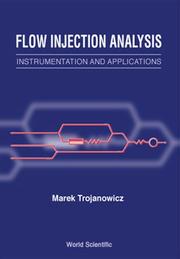
ISBN: 9812813721 9789812813725 9810227108 9789810227104 Year: 2000 Publisher: Singapore River Edge, NJ World Scientific
Abstract | Keywords | Export | Availability | Bookmark
 Loading...
Loading...Choose an application
- Reference Manager
- EndNote
- RefWorks (Direct export to RefWorks)
The concept of flow injection analysis (FIA) was introduced in the mid-seventies. It was preceded by the success of segmented flow analysis, mainly in clinical and environmental analysis. This advance, as well as the development of continuous monitors for process control and environmental monitors, ensured the success of the FIA methodology. As an exceptionally effective means of mechanization for various procedures of wet chemical analysis, the FIA methodology, in use with a whole arsenal of detection methods of modern analytical chemistry, proved to be of great interest to many.The fast and
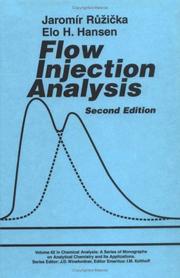
ISBN: 0471813559 Year: 1988 Volume: 62 Publisher: New York Toronto Singapore Wiley
Abstract | Keywords | Export | Availability | Bookmark
 Loading...
Loading...Choose an application
- Reference Manager
- EndNote
- RefWorks (Direct export to RefWorks)
Analytical chemistry --- Analyse instrumentale --- Instrumental analysis --- Instrumentele analyse --- Flow injection analysis --- Chemistry, Analytic --- Chemistry, Physical and theoretical --- Flow injection technique --- Flow method (Analytical chemistry) --- Rapid flow technique --- Stopped flow technique
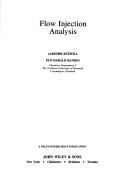
Abstract | Keywords | Export | Availability | Bookmark
 Loading...
Loading...Choose an application
- Reference Manager
- EndNote
- RefWorks (Direct export to RefWorks)
Analytical chemistry --- Technique analytique --- Analytical methods --- Chimie analytique --- Chromatographie --- Chromatography --- analytische chemie --- injection --- Flow injection analysis --- Instrumental analysis --- Chemistry, Analytic --- Chemistry, Physical and theoretical --- Flow injection technique --- Flow method (Analytical chemistry) --- Rapid flow technique --- Stopped flow technique --- Monograph --- Fia
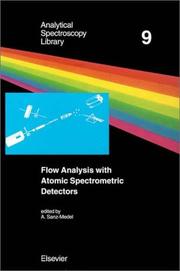
ISBN: 0444823913 9780444823915 9780080531700 0080531709 9786611047528 128104752X Year: 1999 Publisher: Amsterdam ; New York : Elsevier Science,
Abstract | Keywords | Export | Availability | Bookmark
 Loading...
Loading...Choose an application
- Reference Manager
- EndNote
- RefWorks (Direct export to RefWorks)
Flow Analysis (FA) offers a very convenient and fast approach to enhance and automate 'preliminary steps' of analysis (sample dissolution, pretreatments, preconcentrations, etc.) for atomic spectrometric detectors (ASD). Moreover, flow manifolds can ease the well-known problem of sample introduction/presentation to atomisers or even expand the classical scope of atomic/elemental information, characterizing atomic spectrometry, into the realm of molecules and metal-compounds analysis (e.g. by resorting to coupled separation techniques). All these facts could explain both the extraordinary inter
Spectrometric and optical chemical analysis --- fysicochemie --- Atomic spectroscopy. --- Flow injection analysis. --- Flow injection technique --- Flow method (Analytical chemistry) --- Rapid flow technique --- Stopped flow technique --- Instrumental analysis --- Spectroscopy, Atomic --- Spectrum analysis
Book
ISBN: 1283394073 9786613394071 0123859255 0123859247 9780123859242 9781283394079 9780123859259 Year: 2012 Publisher: Amsterdam ; Boston : Elsevier,
Abstract | Keywords | Export | Availability | Bookmark
 Loading...
Loading...Choose an application
- Reference Manager
- EndNote
- RefWorks (Direct export to RefWorks)
"Flow analysis techniques date to over eighty years ago, but modern analytical flow techniques began in the 1950s with the introduction of segmented flow analysis, followed some two decades later by flow injection analysis. Numerous books have been written over the years on flow analysis in general and flow injection analysis in particular. The most widely used detection systems employ flow cells utilising attenuation or radiation of light. This is the first book to focus on these important detection systems and methods, i.e., spectrophotometry, turbidimetry and nephelometry, and techniques based on fluorescence, chemiluminescence, and bioluminescence. It is intended to be complementary to existing monographs"--
Instrumental analysis. --- Flow injection analysis. --- Spectrophotometry. --- Luminescence spectroscopy. --- Luminescence spectrometry --- Spectrometry, Luminescence --- Spectroscopy, Luminescence --- Spectrum analysis --- Luminescent probes --- Analytical chemistry --- Astronomical photometry --- Flow injection technique --- Flow method (Analytical chemistry) --- Rapid flow technique --- Stopped flow technique --- Instrumental analysis --- Chemistry, Physical and theoretical
Book
ISBN: 1608765660 9781608765669 9781607415060 1607415062 Year: 2009 Publisher: New York Nova Science Publishers
Abstract | Keywords | Export | Availability | Bookmark
 Loading...
Loading...Choose an application
- Reference Manager
- EndNote
- RefWorks (Direct export to RefWorks)
Chemical oceanography. --- Flow injection analysis. --- Marine sediments. --- Bottom deposits (Oceanography) --- Bottom sediments (Oceanography) --- Deep-sea deposits --- Deposits, Deep-sea --- Marine deposits --- Sediments, Marine --- Ocean bottom --- Sedimentation and deposition --- Submarine geology --- Sediments (Geology) --- Flow injection technique --- Flow method (Analytical chemistry) --- Rapid flow technique --- Stopped flow technique --- Instrumental analysis --- Marine chemistry --- Oceanography --- Water chemistry
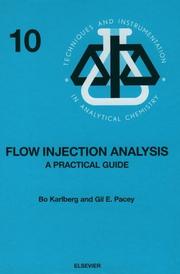
ISBN: 0444880143 9780444880147 9780080875583 0080875580 1281788589 9781281788580 9786611788582 6611788581 0444417443 9780444417442 0444425349 9786611778620 1281778621 0080875556 9780444425348 9780080875552 Year: 1989 Volume: 7 Publisher: Amsterdam ; New York : Elsevier,
Abstract | Keywords | Export | Availability | Bookmark
 Loading...
Loading...Choose an application
- Reference Manager
- EndNote
- RefWorks (Direct export to RefWorks)
This is a practical guide for first-time and experienced users of Flow Injection Analysis (FIA). It gives, not a detailed theoretical analysis, but a ``nuts and bolts'' approach to the description of the technique and how it can be utilized to solve analytical chemical problems.The advantages of flow injection, how, when, why and where it works are all fully explained. Criteria for the choice of hardware and useful hints for maintenance are provided. The large variety of detectors suitable to combine with FIA are discussed, as are special modes of operation, their advantages and their
Analytical chemistry --- Electrochemical analysis --- 543.25 --- 543.25 Electroanalysis. Electrolytic methods. Electrometric methods --- Electroanalysis. Electrolytic methods. Electrometric methods --- Analysis, Electrochemical --- Analysis, Electrolytic --- Electroanalysis --- Electrolytic analysis --- Electrochemistry --- Quantitative --- Analyse électrochimique --- Electrochemical analysis. --- Instrumental analysis. --- Flow injection analysis. --- Flow injection technique --- Flow method (Analytical chemistry) --- Rapid flow technique --- Stopped flow technique --- Instrumental analysis --- Chemistry, Physical and theoretical --- Analytical methods --- Automation --- ELECTROCHEMISTRY
Book
Year: 2020 Publisher: Basel, Switzerland MDPI - Multidisciplinary Digital Publishing Institute
Abstract | Keywords | Export | Availability | Bookmark
 Loading...
Loading...Choose an application
- Reference Manager
- EndNote
- RefWorks (Direct export to RefWorks)
This book introduces the recent technologies introduced for gases capture including CO2, CO, SO2, H2S, NOx, and H2. Various processes and theories for gas capture and removal are presented. The book provides a useful source of information for engineers and specialists, as well as for undergraduate and postgraduate students in the fields of environmental and chemical science and engineering.
in situ gasification chemical looping combustion --- high-flux circulating fluidized bed --- counter-flow moving bed --- gas leakage --- coupling mechanism --- carbon capture and utilization --- biogas upgrading --- calcium carbonate precipitation --- chemical absorption --- gas pressure --- gas content --- gas basic parameters --- rapid estimation technology --- supercritical water oxidation --- high-pressure separation --- oxygen recovery --- energy recovery --- economic analysis --- coal-direct chemical looping combustion --- theoretical methodology --- high-flux --- pressure gradient --- gas mole fraction --- activity --- UNIFAC --- phase equilibrium --- threshold value --- CO2 capture --- calcium looping --- chemical sorption --- anti-attrition --- pore-former particle size --- Reaction --- kinetics --- carbon dioxide --- N-methyldiethanolamine --- L-Arginine --- stopped flow technique --- carbon capture --- CO2 sequestration --- steel-making waste --- steel slag --- H2S absorption --- amine solutions --- glycols --- desulfurization --- aqueous and non-aqueous solutions --- gas diffusion --- unipore diffusion model --- bidisperse diffusion model --- dispersive diffusion model --- refinery plants --- industrial gas streams --- petrochemical processes --- waste gases --- activated carbons --- catalytic activation --- physicochemical structure --- SO2 adsorption --- optimal conceptual design --- market prediction --- economic uncertainty --- environmental impact --- carbon dioxide separation --- Aspen Plus --- CCGT --- Taguchi --- Minitab --- optimization --- 2-Amino-2-Methyl-1-Propanol --- modelling and Simulation --- post-combustion capture --- exergy analysis --- flowsheeting configurations --- nanofluids --- absorption intensification --- mass transfer coefficient --- bubble column --- global warming --- membrane contactor --- removal of NO2 and CO2 --- coke oven --- carbonaceous deposits --- spectral analysis --- mechanism --- arsenene --- doping --- first principles study --- gas adsorption --- two-dimensional --- waste polyurethane foam --- physical activation --- high selectivity --- ultra-micropore --- mechanical activation --- iron ore --- carbonation --- calcination --- recyclability --- mechanochemical reactions --- carbonation kinetics --- MXene --- gas separation --- Knudsen diffusion --- molecular sieving --- transport mechanism --- spiral nozzle --- gas absorption --- spray atomization --- droplet size --- droplet velocity --- gas emission --- capture --- CO2
Book
Year: 2020 Publisher: Basel, Switzerland MDPI - Multidisciplinary Digital Publishing Institute
Abstract | Keywords | Export | Availability | Bookmark
 Loading...
Loading...Choose an application
- Reference Manager
- EndNote
- RefWorks (Direct export to RefWorks)
This book introduces the recent technologies introduced for gases capture including CO2, CO, SO2, H2S, NOx, and H2. Various processes and theories for gas capture and removal are presented. The book provides a useful source of information for engineers and specialists, as well as for undergraduate and postgraduate students in the fields of environmental and chemical science and engineering.
History of engineering & technology --- in situ gasification chemical looping combustion --- high-flux circulating fluidized bed --- counter-flow moving bed --- gas leakage --- coupling mechanism --- carbon capture and utilization --- biogas upgrading --- calcium carbonate precipitation --- chemical absorption --- gas pressure --- gas content --- gas basic parameters --- rapid estimation technology --- supercritical water oxidation --- high-pressure separation --- oxygen recovery --- energy recovery --- economic analysis --- coal-direct chemical looping combustion --- theoretical methodology --- high-flux --- pressure gradient --- gas mole fraction --- activity --- UNIFAC --- phase equilibrium --- threshold value --- CO2 capture --- calcium looping --- chemical sorption --- anti-attrition --- pore-former particle size --- Reaction --- kinetics --- carbon dioxide --- N-methyldiethanolamine --- L-Arginine --- stopped flow technique --- carbon capture --- CO2 sequestration --- steel-making waste --- steel slag --- H2S absorption --- amine solutions --- glycols --- desulfurization --- aqueous and non-aqueous solutions --- gas diffusion --- unipore diffusion model --- bidisperse diffusion model --- dispersive diffusion model --- refinery plants --- industrial gas streams --- petrochemical processes --- waste gases --- activated carbons --- catalytic activation --- physicochemical structure --- SO2 adsorption --- optimal conceptual design --- market prediction --- economic uncertainty --- environmental impact --- carbon dioxide separation --- Aspen Plus --- CCGT --- Taguchi --- Minitab --- optimization --- 2-Amino-2-Methyl-1-Propanol --- modelling and Simulation --- post-combustion capture --- exergy analysis --- flowsheeting configurations --- nanofluids --- absorption intensification --- mass transfer coefficient --- bubble column --- global warming --- membrane contactor --- removal of NO2 and CO2 --- coke oven --- carbonaceous deposits --- spectral analysis --- mechanism --- arsenene --- doping --- first principles study --- gas adsorption --- two-dimensional --- waste polyurethane foam --- physical activation --- high selectivity --- ultra-micropore --- mechanical activation --- iron ore --- carbonation --- calcination --- recyclability --- mechanochemical reactions --- carbonation kinetics --- MXene --- gas separation --- Knudsen diffusion --- molecular sieving --- transport mechanism --- spiral nozzle --- gas absorption --- spray atomization --- droplet size --- droplet velocity --- gas emission --- capture --- CO2
Book
Year: 2020 Publisher: Basel, Switzerland MDPI - Multidisciplinary Digital Publishing Institute
Abstract | Keywords | Export | Availability | Bookmark
 Loading...
Loading...Choose an application
- Reference Manager
- EndNote
- RefWorks (Direct export to RefWorks)
This book introduces the recent technologies introduced for gases capture including CO2, CO, SO2, H2S, NOx, and H2. Various processes and theories for gas capture and removal are presented. The book provides a useful source of information for engineers and specialists, as well as for undergraduate and postgraduate students in the fields of environmental and chemical science and engineering.
History of engineering & technology --- in situ gasification chemical looping combustion --- high-flux circulating fluidized bed --- counter-flow moving bed --- gas leakage --- coupling mechanism --- carbon capture and utilization --- biogas upgrading --- calcium carbonate precipitation --- chemical absorption --- gas pressure --- gas content --- gas basic parameters --- rapid estimation technology --- supercritical water oxidation --- high-pressure separation --- oxygen recovery --- energy recovery --- economic analysis --- coal-direct chemical looping combustion --- theoretical methodology --- high-flux --- pressure gradient --- gas mole fraction --- activity --- UNIFAC --- phase equilibrium --- threshold value --- CO2 capture --- calcium looping --- chemical sorption --- anti-attrition --- pore-former particle size --- Reaction --- kinetics --- carbon dioxide --- N-methyldiethanolamine --- L-Arginine --- stopped flow technique --- carbon capture --- CO2 sequestration --- steel-making waste --- steel slag --- H2S absorption --- amine solutions --- glycols --- desulfurization --- aqueous and non-aqueous solutions --- gas diffusion --- unipore diffusion model --- bidisperse diffusion model --- dispersive diffusion model --- refinery plants --- industrial gas streams --- petrochemical processes --- waste gases --- activated carbons --- catalytic activation --- physicochemical structure --- SO2 adsorption --- optimal conceptual design --- market prediction --- economic uncertainty --- environmental impact --- carbon dioxide separation --- Aspen Plus --- CCGT --- Taguchi --- Minitab --- optimization --- 2-Amino-2-Methyl-1-Propanol --- modelling and Simulation --- post-combustion capture --- exergy analysis --- flowsheeting configurations --- nanofluids --- absorption intensification --- mass transfer coefficient --- bubble column --- global warming --- membrane contactor --- removal of NO2 and CO2 --- coke oven --- carbonaceous deposits --- spectral analysis --- mechanism --- arsenene --- doping --- first principles study --- gas adsorption --- two-dimensional --- waste polyurethane foam --- physical activation --- high selectivity --- ultra-micropore --- mechanical activation --- iron ore --- carbonation --- calcination --- recyclability --- mechanochemical reactions --- carbonation kinetics --- MXene --- gas separation --- Knudsen diffusion --- molecular sieving --- transport mechanism --- spiral nozzle --- gas absorption --- spray atomization --- droplet size --- droplet velocity --- gas emission --- capture --- CO2
| Listing 1 - 10 of 10 |
Sort by
|

 Search
Search Feedback
Feedback About UniCat
About UniCat  Help
Help News
News